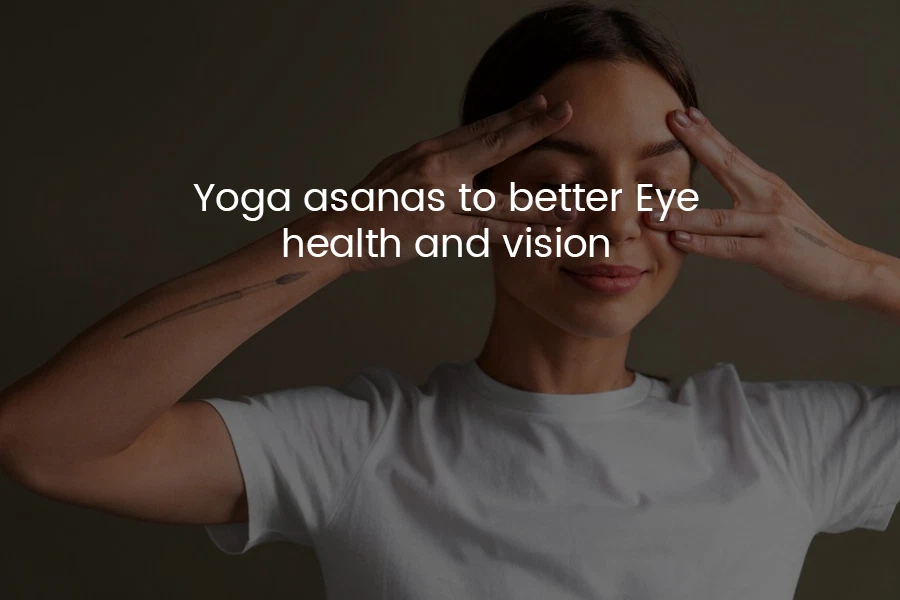Our hectic lives are dominated mainly by screens, from computer screens to mindless social media scrolling and binge-watching.
This has severely affected the eye health of people of all ages, causing them to experience strained eyes, blurred vision, dry eyes, and other eye issues.
The ancient practice of Yoga offers a holistic and natural way to boost eye vision and improve eye health. Simple and quick yoga eye practices can help strengthen eye muscles, reduce eye strain, improve vision, and protect eyes from common eye problems like dry eyes and straining.
Add Eye Yoga to Your Daily Routine
Yoga poses involve simple movements and exercises that relax and rejuvenate the eyes, enhancing visual activity and coordination between the eyes and brain. Practicing below mentioned eye exercises offers numerous benefits for your eyes for years to come.
Yoga Exercises to Enhance and Maintain Eye Vision
Try these 5 simple yoga exercises every day to maintain eye health and eye vision.
1. Palming (Hasta Mudra) Eye Yoga
Palming or Hasta Mudra, a rejuvenating Yoga for good eyesight, provides comforting relief for eyes that are over-stressed and promotes deep relaxation.
Palming the eyes is a great exercise for blurred vision and tired eyes. It helps lower the tension in your eye muscles and helps them relax.
How to Perform Palming
Step1: Sit relaxed
- Choose a comfortable seating position, such as cross-legged on the floor or on a chair with your feet flat on the ground.
- Keep your spine straight and your shoulders relaxed.
Step2: Close your eyes
- Close your eyes gently, allowing your face and eye muscles room to relax.
Step3: Rub your palms together
- Bring your hands in front of your chest and massage your palms together quickly for around 10-15 seconds to generate warmth and energy between them.
Step4: Place palms over the eyes
- Once your palms are warm, gently cup them around your closed eyes.
- Be careful not to put any pressure on your eyes. Your fingertips should rest on your forehead, and the base of your hands should be above your cheekbones.
Step5: Relax and breathe deeply
- Take a deep, relax breath. Concentrate on the warmth of your palms and the darkness generated by your hands covering your eyes.
- Stay in this position for 30 seconds to a few minutes, or as long as you feel comfortable, allowing the warmth to calm your eyes and mind.
Step6: Release softly:
- After you’ve relaxed, carefully slide your hands away from your eyes and let them open lightly. Be mindful of the sense of peace and clarity.
Step7: Repeat if needed
- The whole process can be repeated several times, especially if you experience eye strain or tiredness.
Benefits of Palming Yoga
- Palming Yoga helps to combat the negative effects of prolonged screen exposure. Placing the palm on the eyes creates a dark space, allowing the eyes to relax from constant blue light.
- It helps reduce eye strain, headaches, and issues associated with prolonged exposure to screens.
- It rejuvenates and relaxes the optic nerves and improves brain function.
- Placing warm palms on the eyes activates the nerve endings and energizes the entire body.
- Practicing palming helps to improve vision, promote mindfulness, and enhance concentration.
2. Blinking Eye Yoga
Blinking or Sarvangasana is an excellent eye Yoga exercise that can be added to your daily routine to help reduce eye strain and maintain optimal vision.
Blinking is the best Yoga for dry eyes as it lubricates the eyes and prevents them from drying, which is crucial for clear eye vision.
How to Perform Blinking
Step1: Sit in a comfortable position
- Sit cross-legged on the floor or on a chair with your feet flat on the ground, keeping your back straight and your shoulders relaxed.
- Maintain a stable head and a front facing posture.
Step2: Close your eyes gently
- Close your eyes softly and hold them closed for 2-3 seconds.
- Feel the relaxation of your eye muscles.
Step3: Open your eyes
- Slowly open your eyes and blink rapidly for 10-15 seconds, maintaining a soft focus.
- Aim for smooth, easy blinking without straining or squinting.
Step4: Repeat the process
- After blinking quickly, close your eyes for 2-3 seconds to let them rest.
- Then open them and blink quickly again.
- Repeat the cycle 5-10 times.
Step5: Relax after blinking
- After finishing the blinking exercise, close your eyes for 30 seconds to let them rest and relax completely. This can be combined with deep breathing to increase relaxation.
Benefits of Blinking Yoga
- Blinking exercises help to improve poor blinking patterns and dry eye.
- It also helps to protect against digital devices.
- It promotes blinking reflexes to become more spontaneous.
- Regular blinking Yoga exercises relax eye muscles.
3. Eye Rotations (Netra Vyayam)
Eye rotations, or Eye Rolling, is an eyeball exercise that relieves eyeball strain, reduces strain and pressure, and improves flexibility and muscle strength.
To practice this Yoga to keep your eye healthy simply sit upright with a straight spine and hands resting on your lap and follow below given steps. Netra Vyayam is an excellent exercise for eye muscle flexibility and blood circulation to the eyes and promotes better coordination for sharper vision.
How to Perform Eye Rotations
Step1: Sit in a comfortable position
- Sit straight in a comfortable position, whether cross-legged on the floor or in a chair with your feet flat on the ground.
- Keep your back straight and your shoulders relaxed.
- Close your eyes and take a few deep breaths to help calm your body.
Step2: Look straight forward
- Open your eyes and fix your gaze on a single point directly ahead..
Step3: Begin with up and down movement
- Slowly raise your eyes (as if looking at the ceiling) and hold for a second.
- Then, slowly lower your eyes (as if looking at the floor) and hold for a second.
- Repeat this action 5-10 times while moving slowly and deliberately.
Step4: Side-to-side motion
- Next, shift your gaze to the right side (as if looking at your right ear) and hold for a second.
- Then, carefully shift your gaze to the left side (as if staring at your left ear) and hold for a second.
- Repeat the side-to-side movement 5-10 times.
Step5: Perform circular rotations
- Look up and slowly move your eyeballs in a circular motion, clockwise.
- Begin at the top (12 o’clock), then gradually go to the right (3 o’clock), down (6 o’clock), to the left (9 o’clock), then back up.
- After completing 5-10 clockwise circles, switch directions and rotate your eyes counterclockwise for 5-10 additional rotations.
Step6: Close your eyes and rest
- After you’ve completed the eye rotations, close them for 20-30 seconds and take a few deep breaths.
- Relax your eyes and give them time to rest before opening them again.
Benefits of Eye Rotation Yoga
- Eye rotation Yoga Helps to improve vision and lowers the risks of developing problems associated with eyes like Glaucoma, cataracts, and age-related issues such as macular degeneration.
- It also helps to reduce eye dryness, improve concentration, and boost peripheral vision.
- The Netra Vyayam exercise is renowned Yoga for eyes to remove glasses as it gives flexibility to eye muscles and improves focus.
- Long-term practice of eye rotation helps to clean the eyes, remove toxins, and keep them active.
- It is a great exercise for employees as it cultivates body awareness and inner presence and controls the mind from cluttered thoughts by controlling eyes.
4. Bhramani Pranayam Eye Yoga
Bhramani Pranayam (humming bee breath) is a popular Yoga practice that calms the mind and rejuvenates the eyes. It focuses on deep breathing to improve blood circulation and eye coordination.
How to Perform Bhramani Pranayam
Step1: Sit in a comfortable position
- Sit on the floor in a cross-legged position (such as Sukhasana or Padmasana) or a chair, feet flat on the ground.
- Keep your back straight, neck in line with your spine, and shoulders relaxed.
Step2: Close your eyes.
- Close your eyes and relax the muscles surrounding your eyes and face.
- Take a few deep breaths to reset your mind and body.
Step3: Position your fingers on your face (Shanmukhi Mudra)
- Using both hands, seal your ears with your thumbs.
- Then, slowly lower your eyes (as if looking at the floor) and hold for a second.
- Place your middle fingers on either side of your nose, your ring fingers above your lips, and your little fingers below them. This pose helps you focus your attention.
Step4: Inhale deeply
- Take a deep inhale through your nose, filling your lungs completely.
Step5: Exhale while creating a humming sound
- As you exhale, softly press your tongue on the roof of your mouth to make a faint humming sound, similar to a bee.
- Feel the vibrations in your head, especially near your eyes, ears, and forehead.
Step6: Focus on the vibrations
- Maintain your focus on the relaxing sensations and the sound of the hum. The vibrations will automatically relax the muscles surrounding your eyes and face, relieving tension.
- Take five to ten deep breaths, or as long as it makes you comfortable, then repeat this process.
Step7: Quietly rest
- Release your hands from your face and place them on your knees after the breathing exercises.
- For a short time, keep your eyes closed and inhale deeply and slowly to experience the practice’s calming effects.
Step8: Open your eyes slowly
- Gently open your eyes and return your focus to your environment. Observe how your eyes feel rejuvenated and at ease.
Benefits of Bhramani Pranayam
- Bhramani Pranayam helps to increase the focus and coordination between both eyes.
- It promotes mental clarity and focus and improves eyesight by calming the nerves.
- It helps boost blood flow around the eyes, reducing dark circles and puffiness.
- Controlled breathing calms the mind and reduces eye strain.
5. Up-Down Movement Eye Yoga
The up-down movement is a relaxing Yoga practice that is especially for those who spend long hours in front of a screen.
It involves sitting straight on a flat surface and looking at the ceiling.
If you are looking for what is good for eyesight, the up-down movement Yoga can help improve eye coordination and strengthen the eye muscles.
How to Perform Up-Down Movement Yoga
Step1: Sit in a comfortable position
- Sit straight in a comfortable position, whether cross-legged on the floor or in a chair with your feet flat on the ground.
- Maintain a straight back, relaxed shoulders, and a steady head while facing forward.
Step2: Relax and focus
- Close your eyes briefly, breathe deeply, and relax your face muscles.
- Open your eyes and concentrate on a neutral point straight in front of you, eye level.
Step3: Look upwards:
- Slowly and steadily raise your gaze upward, as if to look at your forehead or the ceiling.
- Hold this position for 2-3 seconds, without straining.
Step4: Look down
- Gently move your eyes downward, as if you were looking at your chin or the ground.
- Hold this position for 2-3 seconds, without straining your eye muscles.
Step5: Repeat the up-and-down action
- Perform ten repetitions of slowly and deliberately shifting your gaze up and down.
- Keep your head still and relaxed, and only move your eyes.
Step6: Rest your eyes
- After you’ve completed the ten repetitions, close your eyes for a few seconds to allow them to rest. Take a few deep breaths.
Optional: Add palming
- For deeper relaxation, try Palming, we have covered Palming above.
- Palming involves rubbing your hands together to create warmth then gently placing your palms over your closed eyes for a minute.
Benefit Up-Down Movement Yoga
- The up-down movement of Yoga helps to stretch and rejuvenate the eye area.
- It helps to improve peripheral vision and improves flexibility.
The up-down movement of the eyes allows them to unwind and relax. - It stimulates blood flow to the eyes to support optimal eye function.
Benefits of Yoga for Improving Eye Health
Relaxes Eye Strain:
The Yoga poses for eyes help to calm and soothe the eye muscles while reducing tension caused by prolonged screen time and stress.
Enhances Vision:
Eye Yoga can help improve eyesight and make them more sharper, reducing the dependence on glasses or contacts.
Improves Blood Circulation:
Enhanced blood circulation nourishes the eyes while promoting optimal eye health.
Improved Flexibility:
Eye Yoga practices help to enhance the flexibility of eye muscles, which can help improve focus and vision.
Reducing the Risk of Eye Diseases:
Eye Yoga practices help to enhance the flexibility of eye muscles, which can help improve focus and vision.
Ageing:
Yoga exercises can help improve age-related issues like macular degeneration and presbyopia.
How Does Yoga Help Improve Eyesight?
The holistic approach to eye health emphasizes physical and mental factors that can impact our eye health. Yoga can help improve eyesight and overall eye health.
Connection Between Yoga and Your Eye Health
Our eyes are considered to be the window to the world; from the time we wake up until we sleep, they are working non-stop. Our vision is associated with more than half of the brain tissues, allowing the brain to receive information.
However, excessive screen time, deficient lighting, eye fatigue, stress, and ageing can cause exhaustion, discomfort, and poor vision. Regular yoga exercises for eyes support eye muscle flexibility, relaxation, and circulation to the eyes, relieve eye strain, and enhance overall well-being.
Conclusion
In light of the growing number of digital gadgets and longer screen times, it is essential that eye health become better.
Yoga poses improve concentration, reduce eye strain, and encourage profound relaxation. You can keep good eye health with a nutrient-rich diet, regular yoga practice, and a healthy lifestyle. Thus, set aside some time in your busy schedule for your well-being and engage in yoga poses to keep your eyes healthy!
Also to achieve overall well-being and maximising the effectiveness of any workout or exercises you follow combine meditation and exercise
References:




